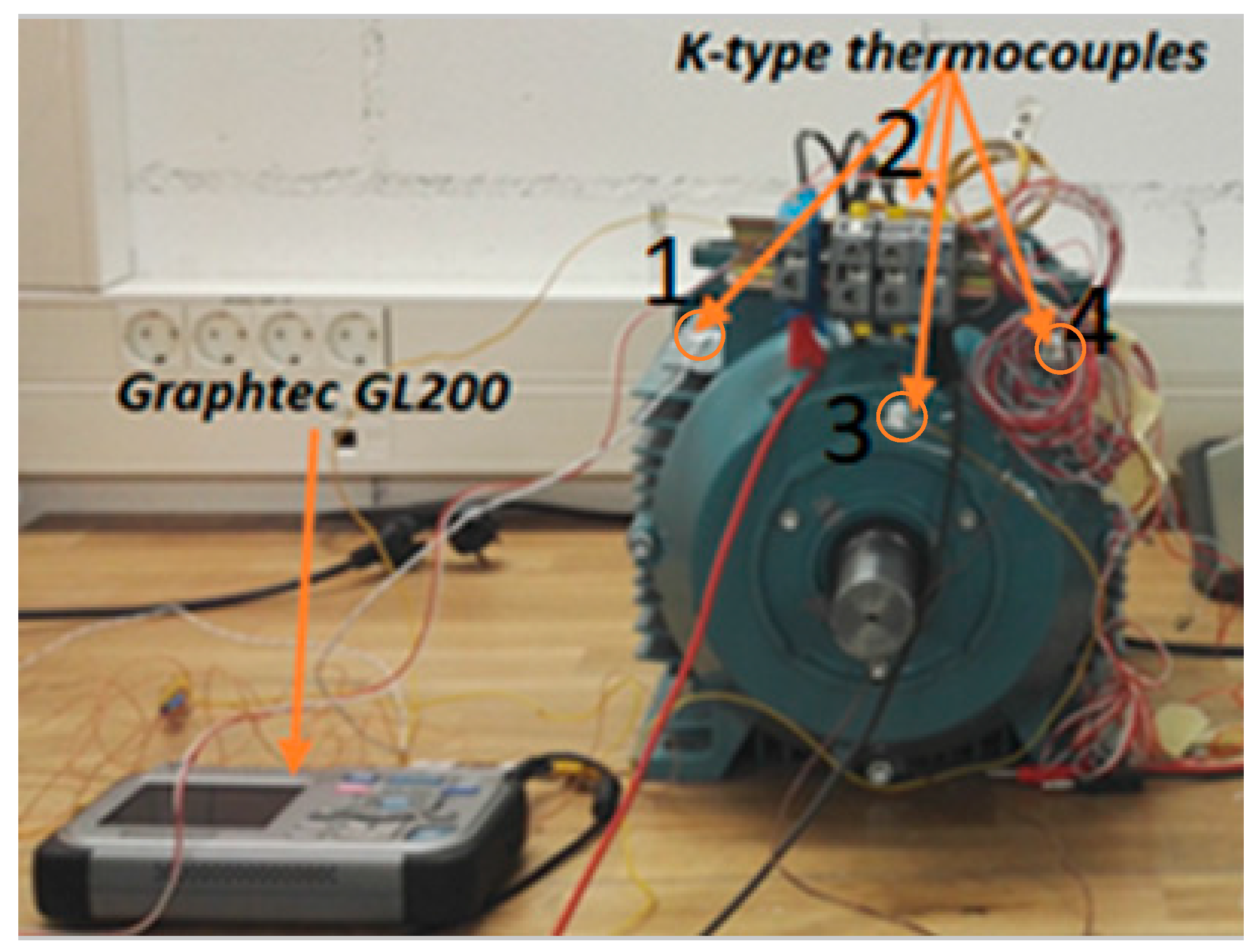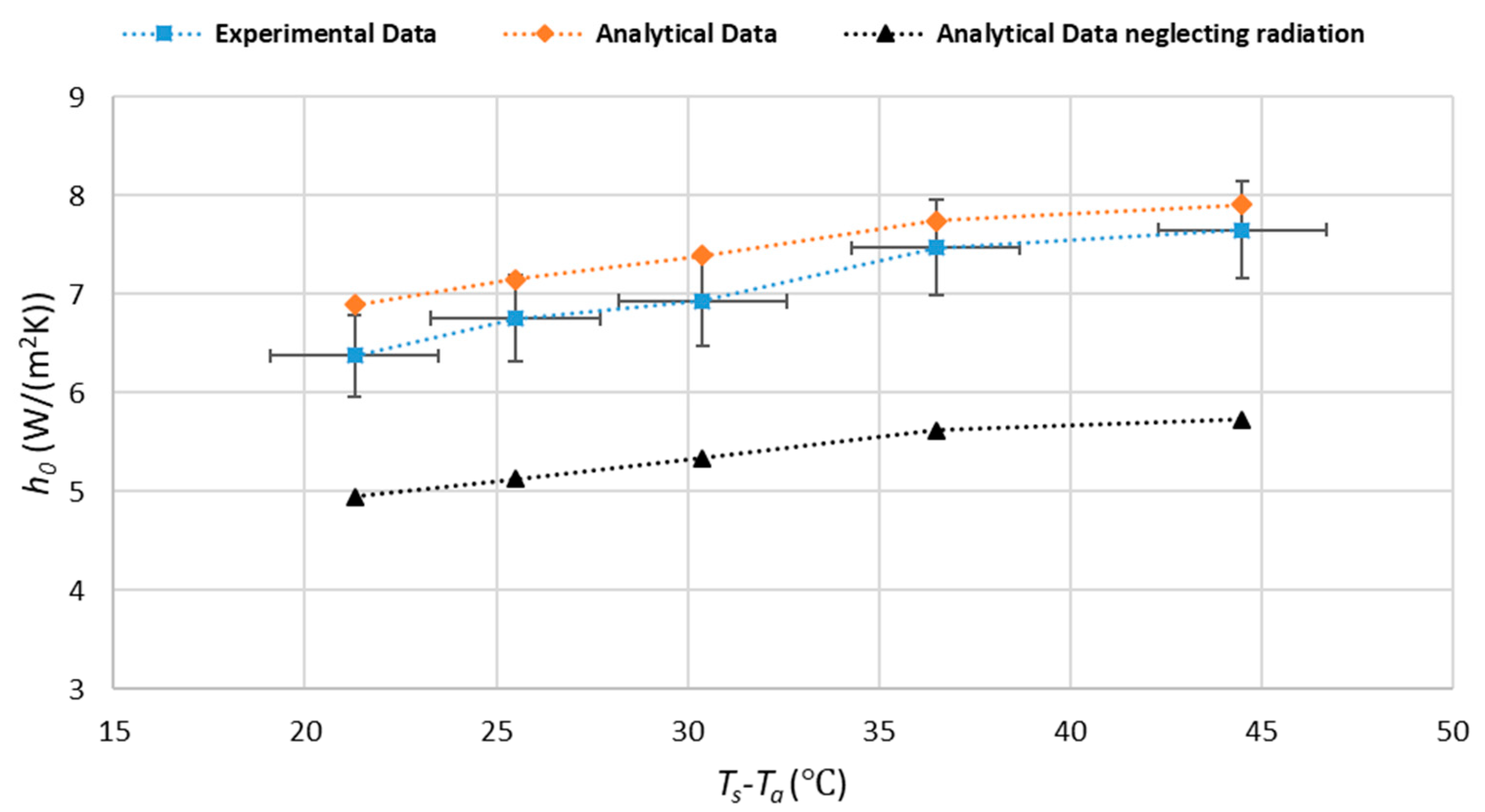Determination of Heat Transfer Coefficient from Housing Surface of a Totally Enclosed Fan-Cooled Machine during Passive Cooling
Abstract
:1. Introduction
2. Analytical Background of Heat-Transfer Coefficient
2.1. Natural Convection
- Horizontal cylinder as a fin channel base.
- Horizontal U-shaped fin channels as semi-open fin channels on the top and bottom of the housing.
- Horizontal flat plate (upper and lower) as semi-open fin channels on the side of the housing.
- Horizontal and vertical flat plates as fin tips; and
- Vertical plates as end caps.
2.2. Radiation
3. Analytical Analysis Approach
4. Experimental Methodology and Analysis Method of Experimental Data
4.1. Experimental Methodology
4.2. Collected Data Analysis Approach
4.3. Uncertainty Analysis
5. Validation and Discussion
6. Conclusions
Author Contributions
Funding
Institutional Review Board Statement
Informed Consent Statement
Data Availability Statement
Conflicts of Interest
References
- Staton, D.A.; Cavagnino, A. Convection Heat Transfer and Flow Calculations Suitable for Electric Machines Thermal Models. IEEE Trans. Ind. Electron. 2008, 55, 3509–3516. [Google Scholar] [CrossRef] [Green Version]
- Boglietti, A.; Cavagnino, A.; Staton, D. Determination of Critical Parameters in Electrical Machine Thermal Models. IEEE Trans. Ind. Appl. 2008, 44, 1150–1159. [Google Scholar] [CrossRef]
- Shams Ghahfarokhi, P.; Kallaste, A.; Vaimann, T.; Belahcen, A. Thermal Analysis of Totally Enclosed Fan Cooled Synchronous Reluctance Motor-state of art. In Proceedings of the 45th Annual Conference of the IEEE Industrial Electronics Society (IECON), Lisbon, Portugal, 14–17 October 2019; pp. 1–5. Available online: https://ieeexplore.ieee.org/document/8927706 (accessed on 12 December 2019).
- Ghahfarokhi, P.S.; Kallaste, A.; Podgornovs, A.; Belahcen, A.; Vaimann, T. Development of analytical thermal analysis tool for synchronous reluctance motors. IET Electr. Power Appl. 2020, 14, 1828–1836. [Google Scholar] [CrossRef]
- Rosu, M.; Zhou, P.; Lin, D.; Ionel, D.; Popescu, M.; Blaabjerg, F.; Rallabandi, V.; Staton, D. Multiphysics Simulation by Design for Electrical Machines, Power Electronics, and Drives; Wiley: Hoboken, NJ, USA, 2018. [Google Scholar]
- Popescu, M.; Staton, D.; Dorrell, D.; Marignetti, F.; Hawkins, D. Study of the thermal aspects in brushless permanent magnet machines performance. In Proceedings of the 2013 IEEE Workshop on Electrical Machines Design, Control and Diagnosis (WEMDCD), Paris, France, 11–12 March 2013; pp. 60–69. [Google Scholar] [CrossRef]
- Miller, T.J.E. Switched Reluctance Motors and Their Control; Oxford University Press: Oxford, UK, 1993; Volume 31. [Google Scholar]
- Staton, D.A.; So, E. Determination of optimal thermal parameters for brushless permanent magnet motor design. In Proceedings of the Conference Record of 1998 IEEE Industry Applications Conference. Thirty-Third IAS Annual Meeting, St. Louis, MO, USA, 12–15 October 1998; Volume 1, pp. 41–49. [Google Scholar] [CrossRef]
- Mellor, P.; Roberts, D.; Turner, D. Lumped parameter thermal model for electrical machines of TEFC design. IEE Proc. B Electr. Power Appl. 1991, 138, 205–218. [Google Scholar] [CrossRef]
- Boglietti, A.; Cavagnino, A.; Lazzari, M.; Pastorelli, M.A. A simplified thermal model for variable-speed self-cooled industrial induction motor. IEEE Trans. Ind. Appl. 2003, 39, 945–952. [Google Scholar] [CrossRef]
- Boglietti, A.; Cavagnino, A.; Staton, D.; Shanel, M.; Mueller, M.; Mejuto, C. Evolution and Modern Approaches for Thermal Analysis of Electrical Machines. IEEE Trans. Ind. Electron. 2009, 56, 871–882. [Google Scholar] [CrossRef] [Green Version]
- Staton, D.; Boglietti, A.; Cavagnino, A. Solving the More Difficult Aspects of Electric Motor Thermal Analysis in Small and Medium Size Industrial Induction Motors. IEEE Trans. Energy Convers. 2005, 20, 620–628. [Google Scholar] [CrossRef] [Green Version]
- Boglietti, A.; Cavagnino, A.; Parvis, M.; Vallan, A. Evaluation of radiation thermal resistances in industrial motors. IEEE Trans. Ind. Appl. 2006, 42, 688–693. [Google Scholar] [CrossRef] [Green Version]
- Boglietti, A.; Vallan, A. Measurement of Housing Thermal Resistances in Industrial Motors. In Proceedings of the IEEE Instrumentation and Measurement Technology Conference, Sorrento, Italy, 24–27 April 2006; pp. 1321–1325. [Google Scholar] [CrossRef]
- Rao, V.D.; Naidu, S.; Rao, B.G.; Sharma, K.V. Heat transfer from a horizontal fin array by natural convection and radiation—A conjugate analysis. Int. J. Heat Mass Transf. 2006, 49, 3379–3391. [Google Scholar] [CrossRef]
- Ahmadi, M.; Mostafavi, G.; Bahrami, M. Natural convection from rectangular interrupted fins. Int. J. Therm. Sci. 2014, 82, 62–71. [Google Scholar] [CrossRef]
- Gai, Y.; Kimiabeigi, M.; Chong, Y.C.; Widmer, J.D.; Deng, X.; Popescu, M.; Goss, J.; Staton, D.A.; Steven, A. Cooling of Automotive Traction Motors: Schemes, Examples, and Computation Methods. IEEE Trans. Ind. Electron. 2019, 66, 1681–1692. [Google Scholar] [CrossRef] [Green Version]
- Cengel, Y.A. Heat Transfer: A Practical Approach; McGraw-Hill: New York, NY, USA, 2004. [Google Scholar]
- Bejan, A.; Kraus, A.D. Heat Transfer Handbook; John Wiley & Sons: Hoboken, NJ, USA, 2003. [Google Scholar]
- Shams Ghahfarokhi, P.; Kallaste, A.; Vaimann, T.; Belahcen, A. Natural convection from flat side’s of coil system. In Proceedings of the 19th International Scientific Conference on Electric Power Engineering (EPE), Brno, Czech Republic, 16–18 May 2018; pp. 1–5. [Google Scholar] [CrossRef]
- Jones, C.D.; Smith, L.F. Optimum Arrangement of Rectangular Fins on Horizontal Surfaces for Free-Convection Heat Transfer. J. Heat Transf. 1970, 92, 6–10. [Google Scholar] [CrossRef]
- Shams Ghahfarokhi, P.; Kallaste, A.; Vaimann, T.; Rassolkin, A.; Belahcen, A. Determination of natural convection heat transfer coefficient over the fin side of a coil system. Int. J. Heat Mass Transf. 2018, 126, 677–682. [Google Scholar] [CrossRef]
- Motor-CAD Software by Motor Design—EMag, Therm and Lab. Available online: https://www.motor-design.com/motor-cad-software/ (accessed on 17 June 2021).
- Pyrhonen, J.; Jokinen, T.; Hrabovcová, V. Design of Rotating Electrical Machines; Wiley: Hoboken, NJ, USA, 2008. [Google Scholar]
- Popescu, M.; Staton, D.A.; Boglietti, A.; Cavagnino, A.; Hawkins, D.; Goss, J. Modern Heat Extraction Systems for Power Traction Machines—A Review. IEEE Trans. Ind. Appl. 2016, 52, 2167–2175. [Google Scholar] [CrossRef]
- Markovic, M.; Saunders, L.; Perriard, Y. Determination of the Thermal Convection Coefficient for a Small Electric Motor. In Proceedings of the Conference Record of the 2006 IEEE Industry Applications Conference Forty-First IAS Annual Meeting, Tampa, FL, USA, 8–12 October 2006; Volume 1, pp. 58–61. [Google Scholar] [CrossRef]
- Meksi, O.; Vargas, A.O. Numerical and experimental determination of external heat transfer coefficient in small TENV electric machines. In Proceedings of the 2015 IEEE Energy Conversion Congress and Exposition (ECCE), Montreal, QC, Canada, 20–24 September 2015; pp. 2742–2749. [Google Scholar] [CrossRef]
- Shams Ghahfarokhi, P.; Kallaste, A.; Podgornovs, A.; Belahcen, A.; Vaimann, T.; Asad, B. Determination of heat transfer coefficient of finned housing of a TEFC variable speed motor. Electr. Eng. 2020, 103, 1–9. [Google Scholar] [CrossRef]
- Boglietti, A.; Cavagnino, A.; Staton, D.A. Thermal analysis of TEFC induction motors. In Proceedings of the 38th IAS Annual Meeting on Conference Record of the Industry Applications Conference, Salt Lake City, UT, USA, 12–16 October 2003; Volume 2, pp. 849–856. [Google Scholar] [CrossRef]
- Boglietti, A.; Cavagnino, A.; Staton, D. TEFC Induction Motors Thermal Models: A Parameter Sensitivity Analysis. IEEE Trans. Ind. Appl. 2005, 41, 756–763. [Google Scholar] [CrossRef] [Green Version]
- Shams Ghahfarokhi, P.; Kallaste, A.; Vaimann, T.; Rassolkin, A.; Belahcen, A. Steady-State Thermal Model of a Synchronous Reluctance Motor. In Proceedings of the 2018 IEEE 59th International Scientific Conference on Power and Electrical Engineering of Riga Technical University (RTUCON), Riga, Latvia, 12–13 November 2019; pp. 1–5. [Google Scholar] [CrossRef] [Green Version]






| Mean Fin’s Length (mm) | Mean Fin’s Height (mm) | Mean Fin’s Spacing (mm) | Number of Fins | |
|---|---|---|---|---|
| Fins on the top of the housing | 34.38 | 24.37 | 11.86 | 12 |
| Fins on the underside of the housing | 184.25 | 24.37 | 11.86 | 12 |
| Fins on the sides of the housing | 180.75 | 24.83 | 9.70 | 30 |
| Component | Convection Correlation | Emissivity | View Factor | Area (m2) |
|---|---|---|---|---|
| Fin base | Horizontal cylinder | 0.8 | 1 | 0.0918 |
| Fins on top of the housing | Horizontal fin channel | 0.8 | 0 | 0.0201 |
| Fins on undersides of the housing | Horizontal fin channel | 0.8 | 0 | 0.1078 |
| Fins on the sides of the housing | Horizontal flat plate (upper and lower faces) | 0.8 | 0 | 0.2692 |
| Fin tips | Horizontal and vertical flat plate | 0.8 | 1 | 0.0209 |
| End caps | Vertical flat plate | 0.8 | 1 | 0.0831 |
| V (v) | Ts (°C) | Ta (°C) | h0 (W/m2/K) |
|---|---|---|---|
| 15 | 42 | 20.5 | 6.91 |
| 17 | 47 | 21.6 | 7.14 |
| 19 | 51.5 | 20.8 | 7.39 |
| 22 | 61 | 21.6 | 7.78 |
| 25 | 64.5 | 21.2 | 7.93 |
| V (v) | Ts (°C) | Ta (°C) | h0 (W/m2/K) |
|---|---|---|---|
| 15 | 42 | 20.5 | 4.95 |
| 17 | 47 | 21.6 | 5.13 |
| 19 | 51.5 | 20.8 | 5.34 |
| 22 | 61 | 21.6 | 5.62 |
| 25 | 64.5 | 21.2 | 5.73 |
| V (v) | I (A) | Ts (°C) | Ta (°C) | QT (W) | h0 (W/m2/K) |
|---|---|---|---|---|---|
| 15 | 6.45 | 42 | 20.5 | 96.75 | 6.37 |
| 17 | 7.12 | 47 | 21.6 | 121.04 | 6.76 |
| 19 | 7.79 | 51.5 | 20.8 | 148.01 | 6.93 |
| 22 | 8.71 | 61 | 21.6 | 191.62 | 7.47 |
| 25 | 9.57 | 64.5 | 21.2 | 239.25 | 7.65 |
Publisher’s Note: MDPI stays neutral with regard to jurisdictional claims in published maps and institutional affiliations. |
© 2021 by the authors. Licensee MDPI, Basel, Switzerland. This article is an open access article distributed under the terms and conditions of the Creative Commons Attribution (CC BY) license (https://creativecommons.org/licenses/by/4.0/).
Share and Cite
Shams Ghahfarokhi, P.; Podgornovs, A.; Kallaste, A.; Cardoso, A.J.M.; Belahcen, A.; Vaimann, T.; Asad, B.; Tiismus, H. Determination of Heat Transfer Coefficient from Housing Surface of a Totally Enclosed Fan-Cooled Machine during Passive Cooling. Machines 2021, 9, 120. https://doi.org/10.3390/machines9060120
Shams Ghahfarokhi P, Podgornovs A, Kallaste A, Cardoso AJM, Belahcen A, Vaimann T, Asad B, Tiismus H. Determination of Heat Transfer Coefficient from Housing Surface of a Totally Enclosed Fan-Cooled Machine during Passive Cooling. Machines. 2021; 9(6):120. https://doi.org/10.3390/machines9060120
Chicago/Turabian StyleShams Ghahfarokhi, Payam, Andrejs Podgornovs, Ants Kallaste, Antonio J. Marques Cardoso, Anouar Belahcen, Toomas Vaimann, Bilal Asad, and Hans Tiismus. 2021. "Determination of Heat Transfer Coefficient from Housing Surface of a Totally Enclosed Fan-Cooled Machine during Passive Cooling" Machines 9, no. 6: 120. https://doi.org/10.3390/machines9060120










